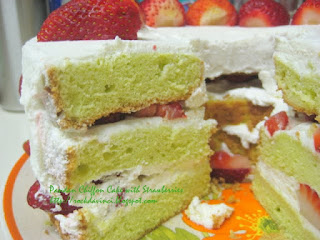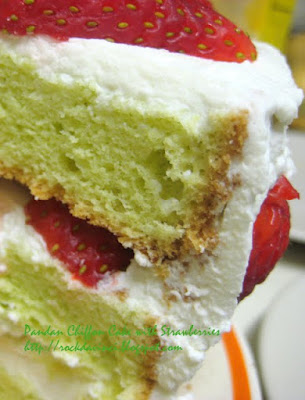Taro root filling:
300 g Pre-peeled Large Taro, cut into small chunks and cooked (microwaved), and mashed
2 Tbsp Milk
1/2 C sugar
Method:
Microwave the Taro root chunks on a plate with 1 Tbsp of water and covered with microwave plastic cover shield. Use "potato" setting to cook till tender. Stir from time to time to make sure that they are cooked evenly and not overcooked to become 'petrified'.
Remove from the microwave and let it steam for few minutes without uncovering.
Add all ingredients in the food processor. Process until it becomes paste like consistency.
The original filling recipe ... I can't remember which blog it is right now, and I will correct this information later, but was for Sweet Potatoes and 1/4 C milk. I did mix the milk and sugar and chunk taro roots at the beginning. But when the putting the taro roots through through the "riser" didn't turn out ideally, I was spoon transferring them to the food processor. That's when I noticed the consistency of the mixture is already quite soft with just about 2 Tbsp of milk. I had about 2 Tbsp of milk left and likely some melted sugar in it. (Luckily the taro root is quite flavorful and has sweet tasting. If not, add 1/4 C more of sugar.)
Refrigerate for a couple of hours, covered.
Scoop out with 1 Tbsp size cookie scoop onto plate. *Keep it cold for ease of handling
** Depending on the size of the mooncake molds, cut the size of the filling to 1/2 Tbsp or press out the mooncake skin thin. ** My personal preference is thick outershell than the filling.
MOCHI MOONCAKE INGREDIENTS:
230 g SHIRATAMAKO "powder" form.
1 Tb Vanilla Sugar powder + 1/4 C minus 1 Tb Sugar
1 Tb MATCHA (Green Tea Powder)
2/3 C water
Japanese Potato Starch - KATAKURIKO 1/2 C
Dough Prep:
In a microwaveable bowl, add 230 g SHIRATAMAKO powder. In a small saucepan, mix sugar and Matcha together and mix well. Add 2 Tb of water to mix.
Then, add some more to mix, so that MATCHA is incorporated; then, add the rest of the water and mix well. Then, heat the mixture over medium heat till sugar melts, but NOT boiling.
Add the liquid mixture into SHIRATAMAKO powder. Stir well.
If the texture looks dry. Add some more water until pasty consistency is formed. Ear lobe soft dough. Not Liquidy. **The texture is totally different than when using SHIRATAMAKO GRANULES. (Check my previous blog posting's image on DAIFUKU-MOCHI).
Microwave it 1-1/2 min. Take it out, mix. You should see some rubbery formation at the edge of the glass bowl. *Note: Nuking time depends on the power of your microwave.
Return to microwave for another 1-1/2 min. But stop at 45 sec to bring out to stir. Is it rubbery and translucent? The ultimate result you want is "translucent" stage MOCHI. Stir with sturdy spoon to mix the dough to help incorporate mixture. Return to microwave again, if needed, to nuke it till it is at 'transluscent' stage, but not petrified. Be careful - it is dead hot - Take it out and Stir crazy. So, you need to know your microwave's power.
Transfer to the plate sprinkled with KATAKURIKO. Cool to Medium Hot.
Measure with sight and snap off approx two tablespoon of mochi.
Powder your fingers with KATAKURIKO and start pressing it out into round shape.
Place one taro filling. Start enclosing it in BAO making method.
Then, roll it in KATAKURIKO completely. Set aside until you have created at least 4 filled rounds.
Then, Select the mooncake mold. Insert the rounded mochi with filling into the mold.
Place the mold down on work surface covered with KATAKURIKO.
Press down on plunger without letting any mochi leak out from the molding's end.
"Pressing down the plunger" also imprints the 'design'/'pattern' of the mold onto the MOCHI.
Lift the mold off the work surface.
Push the plunger down to push the finished mooncake out.
Surprise!! MOCHI MOONCAKE!
When I was making the DAIFUKU MOCHI with the SHIRATAMAKO Granules, I had to work quickly to enlcose the filling. But when I was working to make the MOCHI MOONCAKE, I remembered how cotton soft the outer MOCHI to the touch when DAIFUKU is formed. This would not work well when you need the finished product to hold the shape after unmolding from the mooncake mold. I noticed, as I was exploring and timing how quickly it starts to mishape after unmolding, the MOCHI dough started to cool, and as I worked with the cooled MOCHI, the finished MOCHI MOONCAKE kept the pattern and the shape better. So, my advice is to let the MOCHI cool to Medium hot. Prepare at least 4 filled rounds.
Then, start forming in the mooncake mold.
*Make sure the filld rounds are covered completely in KATAKURIKO to prevent from sticking onto the molds.
Keep in covered container. Then individually wrap in plastic wrap or in gift box.
My first round is a success. So, I have two more weeks to turn out moon cake varieties in time for the Chinese Mid-Autumn Festival for my family.













